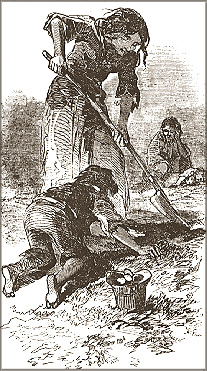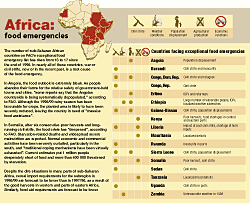The new millennium promises excitement and hope for the future fueled by new advancements in medicine, agriculture, and technology. However, there is increasing concern over predications that the world population will reach 8 billion in the next 25 years. Currently, many regions in Africa and Asia are experiencing a food crisis that is contributing to hunger, malnutrition, and starvation. The expected population increase will only make the food crisis worse - or will it? This APSnet feature briefly explores some of the issues surrounding world population and hunger as influenced by plant disease. The APS graduate student committee is sponsoring a symposium on the world food crisis at the 1999 APS/CPS joint annual meeting in Montreal, Canada. The symposium will further explore some of the issues presented here, and highlight the role that plant pathology plays in combating world hunger.
Plant Pathogens Influencing Culture: Robigalia
Throughout history, food crises caused by plant disease epidemics have resulted in starvation and displacement of millions of people. One of the first examples of plant pathogens influencing religion and cultural practices was the result of rust diseases of cereals. Around 700 B.C. the ancient Romans created the ceremony of Robigalia to honor the Rust God evoked as either a male (Robigus) or female (Robigo) divinity. Robigalia involves a procession, prayers, and sacrifices to appease (and distract) the god of rust, hoping to prevent destruction of wheat crops.
 |
Every spring around April 25th, the graduate students in the Department of Plant Pathology & Microbiology at Texas A&M celebrate Robigalia. The festival includes a re-enactment of the ceremony honoring either Robigus or Robigo, and includes chanting and sacrificial offerings. |
Historical Epidemics
The Irish Famine, 1846-1850
A most devastating event that vividly illustrates the consequences of a plant disease was the Irish Potato Famine of the 1840's. By the end of the famine, the population of Ireland dropped from 8 million to 5 million people. Approximately 1.5 million of those victims died as a result of either famine or disease, and the rest were forced to immigrate to North America. As with many famines, politics were directly related to the availability of food. Many Irish peasants grew cereal crops or raised animals to pay for "rent" and taxes. Potatoes were grown near dwellings, and often constituted the sole food of an Irish peasant's daily diet. When the potatoes were struck by the blight caused by Phytophthora infestans, the peasants had no choice but to leave their homes or starve to death.

|
Source:
"Digging for Potatoes," from The Illustrated London News, 1849 taken from "Interpreting The Irish Famine, 1846-1850". |
The Irish Potato Famine clearly illustrates the far-reaching effects plant pathogens can have on religion, politics, art, economics, and culture. Many songs, poems, and works of art were inspired by the famine and continue to be produced. A wonderful web site, created by Conrad Jay Bladey, features the artistic and historical influences of the Irish Famine. (http://mysite.verizon.net/cbladey/irish/HomePage.home.html#Menu).
The Great Hunger of 1044 was caused by poor weather, animal diseases, and several unknown plant diseases (possibly ergot and root rots). This led to widespread famine and disease throughout medieval Europe.
The Bengal Famine of 1943 was the result of a combination of human disasters and a devastating disease of rice called brown spot caused by Bipolaris oryzae. The Bengal Famine led to the death of an estimated 4 million people in India.
Current food crisis conditions exist in the northern parts of China where plant diseases and pests threaten 22 million hectares. In addition, drought, pests, and plant diseases endanger 300,000 Somalis who are at high risk for another famine similar to the one in 1991/1992. (For more information, http://www.fao.org/)
 |
Source: FAO Global Information and Early Warning Systems on food and agriculture (GIEWS) April 1999 http://www.fao.org/. Click image for an enlarged view. |
A growing world population
In 1996, the world's population was 5.2 billion. It will grow to 8.3 billion by 2025 and almost 10 billion by 2050, according to the median population projection of the United Nations Population Division.
Click here to see a graph of World Population, 1950-2050. To feed this many people, will we need twice as much food as there is now?
Is population a problem?
Data suggests that population increases are not causing food crises, rather that natural disasters, plant diseases, and human influences are the real culprits. Food First, at The Institute for Food and Development Policy, has identified several myths about hunger and population:
Myth: There just isn't enough food produced in the world to feed everyone. In reality, hunger and malnutrition are a result of poverty and lack of accessibility to quality food. Food First estimates that there is enough food to provide at least 4.3 pounds of food per person per day.
Myth: Hunger is the result of overpopulation. Famine and malnutrition are often the result of a combination of factors including adverse weather, poor agricultural production (pests, pathogens, lack of inputs/water), civil strife, population displacement, inadequate food distribution, and economic sanctions.
"World Hunger: Twelve Myths, 2nd Edition" is available from the Institute for Food and Development Policy at http://www.foodfirst.org/.
Understanding world hunger: Some Definitions
Hunger is a complex problem with several factors contributing to a food crisis for people on all continents. There are several topics related to world hunger that appear similar, but upon further reflection are separate issues demanding different solutions. For instance,
- food security vs. food deprivation
- malnutrition vs. undernutrition vs. famine
- low birth weight
- poverty vs. poor vs. low income
Often, during a food crisis, several factors contribute to reduction in the amount of and quality of food that is available for consumption. For example, food security is defined at the ability of all people to have access to quality food at all times. The current situation in Somalia is that 1 million people face food shortages and an estimated 400,000 are threatened by starvation. They are facing a crisis in food security due to poor harvests (adverse weather, plant disease and pest problems) and political instability. In addition, many people are considered to be food deprived, especially in the southern regions of Somalia, where civil strife has curtailed agricultural production and food distribution. Therefore, even though food is available, people are being deprived of their access to the food supply.
Tufts University has links to several other hunger-related resources. Click here to go to the Tufts University nutrition website.
Potential Roles for Plant Pathologists
Clearly, world hunger is a complicated situation. However, there are several ways that plant pathologists may be able to help. After reviewing a number of different resources on food crisis and world hunger, I found very little information on the effects of plant pathogens and plant diseases on food security. In the cases where plant diseases were cited, virtually no information was provided on specific pathogens. On the other hand, there are many research papers in scientific journals citing devastating crop losses due to plant pathogens, such as the African cassava geminivirus and rust fungi.
History illustrates that plant diseases can have a significant effect on human society. Dr. Karen-Beth Scholthof, a plant virologist at Texas A&M University, has written articles on the link between plant pathology and human health. One article, "A role for plant pathology in public health?" (to be published in the CDC journal Emerging Infectious Diseases) is previewed here. (Click here to see this article). In an upcoming letter to the editor of Phytopathology News (August, 1999 issue), Scholthof argues that conceptual use of the term 'ethnophytopathology' may provide a mechanism to focus the public on the role of plant pathology in public health. (Click here to see this article).
Plant pathologists can help identify disease problems and help disseminate information to both private and government organizations for use in education and in planning actions to reduce world hunger. Plant pathologists can also help maximize agricultural production by assisting in crop improvements, reducing input requirements, and through better assessment of disease problems. Long term solutions may be found through sustainable agriculture and integrated pest management (IPM). By combining knowledge and resources, plant pathologists can work together toward increasing food security and reducing world hunger.
Many of the issues introduced in this feature story will be further explored at the World Food Crisis Symposium from 1:00 to 5:00 p.m. Monday, August 9, 1999 at the APS/CPS annual meeting in Montreal, Canada. (Click here to read the abstracts for the symposium papers).
Plan to attend!
